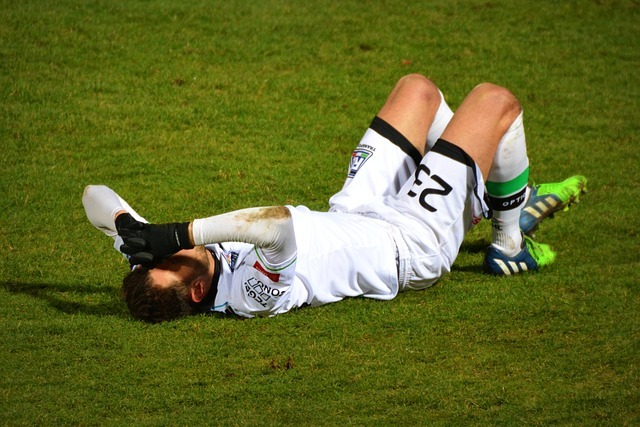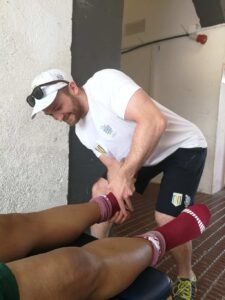Understanding Muscle Strains

Many athletes, those with active lifestyles and sedentary individuals suffer from muscular strains. Often they are confused as to why it happened to them, the severity of it, and the timeline for recovery. During the World Sports Games I attended in Spain, I dealt with a lot of recent hamstring strains. My goal in this short article is to clear up the confusion and give you a clear understanding of muscular strains.
Muscular Strains
To start off, strains occur to muscles and sprains happen to ligaments. For the sake of this article, we will keep it simple and discuss muscular strains. Sometimes an injury is considered a sprain/strain because there may be a strain to the muscle alongside a sprain of ligaments at the joint.
We will also divide muscular strains into two categories, chronic (long term) over-use and acute (short term) traumatic strains. Often an over-use strain can be confusing for the patient as there is no \”single\” event that is the clear cause of the injury. Whereas in a traumatic strain injury it is obvious as to the cause of the strain. In these cases, patients often say \”yeah, I picked up that TV and my back went into spasm”.
So, let’s first discuss the over-use strain that is all too common.
Long term Over Use Strain
Often these muscular injuries are not caused by a single event. In many cases, these injuries are caused by cumulative micro-injuries. Over time, these micro-injuries reduce the capacity of our muscles and joints to resist injury. This process is not limited to any particular activity, but anything you do repetitively.
This chronic cycle begins with overwork, such as long duration of sitting or long distance running. This prolonged overwork may lead to muscular imbalances and weak/tense muscles/soft tissue. These weak and/or tight muscles lead to excessive friction, pressure and tension to the local muscles, ligaments, tendons, and fascia (connective tissue). In turn, this results in decreased circulation and swelling and a lack of oxygen to the area. Due to this hypoxic state (lack of oxygen to an area), the formation of adhesions and/or scar tissue occurs to the area, which decreases the function of the local structures. This becomes a vicious cycle that over time results in weaker and more tensed muscles and soft tissue. In this way the cycle keeps on churning until the body sends off the alarm system that something is wrong.
That alarm system comes in the form of a pain!
Now onto the dreaded acute/traumatic strain that occurs to people often, and can be extremely painful and life-altering for a stretch of time, depending on the “grade” of your strain. The below information is from the website Physiotherapy Notes and more information can be found on their website here.

Grade I Muscle Strain
In grade I muscle strain, the muscle or tendon is overstretched. Small tears to muscle fibers may or may not occur. You may have mild pain with or without swelling. Grade I strain is also called mild muscle strain.
Grade II Muscle Strain
Also called moderate muscle strain, grade II strain occurs when the muscle or its tendon is overstretched with more of the fibers torn. The tear is not a complete tear. Symptoms may include moderate pain with swelling. The area of injury is tender. Bruising may occur if small blood vessels at the site of injury are damaged as well. Movement may be difficult because of pain.
Grade III Muscle Strain
Grade III strain, or severe muscle strain, is the most serious among the three grades of muscle strains. Most of the muscle fibers are torn. In some cases, the muscle is completely torn or ruptured. Pain, swelling, tenderness, and bruising are usually present. Movement is usually difficult.
Moderate and severe muscle strains should be seen by a qualified health care provider. For grade I muscle strains, simple home remedies, such as applying Peace and Love methods (as detailed in this blog post) may be just enough to manage symptoms.
Preventative Measures
Here are some corrective strategies to decrease the chances of the over-use strain or acute traumatic strain injuries. Keep in mind, even if everything is “ideal” you still may end up with strains and sprains if your sport or activity is strenuous in nature.
- Corrective exercises: This will help combat against muscular imbalances which can cause biomechanical issues and increased strain on the body.
- Micro-breaks: Break up the repetitions of your activity or sport.
- Proper Technique: Less strain on the body from optimal efficiency and performance.
- Rest and Recovery: Helps get the body back to a steady state and prevents excessive fatigue.
- Equipment: Key to performance, efficiency and reduction of strain on the body.
Treatment Options
If a strain injury does occur, there are many treatment options one can consider in addition to the PEACE and LOVE methods we discussed before in this blog post. In our office, we typically utilize 3 key treatment options that not all clinics do, and they are as follows:
-
- Instrument Assisted Soft Tissue Release
- Spinal Adjustments
- Sports Taping
You can click here to learn more about our treatment approach.
As always, if you have any questions feel free to contact us here, or you can visit our Facebook page for more information and for more updates on what we’re up to.




